Butter Dishes, Part III
by Mark A. Nye
Issue No. 178 - February 1988
It has been a full year since Part I of this series on Cambridge butter dishes was published! When it was started I never thought a year would pass before the series was completed. For one reason or another, this topic kept getting put aside month after month and all of a sudden a year had passed. For those of you who have been breathlessly awaiting the final chapter of the butter dish story, your wait is over. I have finished it.
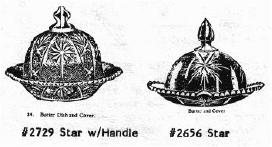 Known to Pattern Glass collectors as "Star with Handle," the first
butter dish to be covered (no pun intended) in this article was made
during the same years as the Buzz Saw line. Introduced between 1910-15
and discontinued during the early to mid 1920s, it is from the "Medium
Pressed" #2729 line (shown at far left).
Known to Pattern Glass collectors as "Star with Handle," the first
butter dish to be covered (no pun intended) in this article was made
during the same years as the Buzz Saw line. Introduced between 1910-15
and discontinued during the early to mid 1920s, it is from the "Medium
Pressed" #2729 line (shown at far left).
Apparently never named by Cambridge, Star with Handle is quite descriptive and in the absence of a known factory name, its use by Cambridge collectors is encouraged. The "handle" is readily seen on most, if not all, pieces, including the butter, but it is most pronounced on tall items such as the #30 jug.
Note that this pattern has a 12 point star, including the point that serves as a handle. Compare this to the other Star pattern #2656 (near left), which has a six or eight point star.
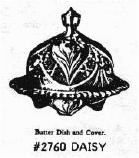 Somewhat unusual in that there are both flat and toed items, the
#2760 or Daisy Design (at right) was brought out in 1911 and some items from the
line continued to be produced until sometime after 1921. Produced in
crystal, crystal with ruby flashing and gilt trim, and with what at the
time was referred to as "silver etched effect," the Daisy line is also
known to Pattern Glass collectors as "Red Sunflower." The basis of this
name being the ruby flashed items.
Somewhat unusual in that there are both flat and toed items, the
#2760 or Daisy Design (at right) was brought out in 1911 and some items from the
line continued to be produced until sometime after 1921. Produced in
crystal, crystal with ruby flashing and gilt trim, and with what at the
time was referred to as "silver etched effect," the Daisy line is also
known to Pattern Glass collectors as "Red Sunflower." The basis of this
name being the ruby flashed items.
The Daisy butter dish known in crystal, both plain and with ruby flashing is toed and thus unique among Cambridge butters.
The popular Strawberry or #2780 pattern, designated by Cambridge as "Light Pressed," was introduced circa June 1911 and appears to have been discontinued around 1919-20.
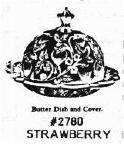 The Strawberry pattern (left) has been the victim of several reproduction
efforts but, so far as it is known, the butter dish has not been
remade. It would appear the reproductions are true reproductions, made
from new molds, since there is strong evidence the molds for the
Strawberry line were destroyed in 1940, after gathering dust on the
mold storage room shelves for some twenty years. Known to Carnival
Glass collectors as Inverted Strawberry, Carnival Strawberry butters
are known in two colors, marigold and purple.
The Strawberry pattern (left) has been the victim of several reproduction
efforts but, so far as it is known, the butter dish has not been
remade. It would appear the reproductions are true reproductions, made
from new molds, since there is strong evidence the molds for the
Strawberry line were destroyed in 1940, after gathering dust on the
mold storage room shelves for some twenty years. Known to Carnival
Glass collectors as Inverted Strawberry, Carnival Strawberry butters
are known in two colors, marigold and purple.
It was 1908 when Cambridge became the second major glass house to produce what is now known as Carnival Glass. Several years later, circa 1916-17, Cambridge once again produced Carnival glass and there is some indication Cambridge Carnival glass was also issued again in the late 1920s.
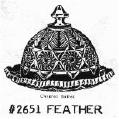 In addition to Strawberry, it is possible to find both the Feather (shown at right)
and Thistle line butters in marigold and purple Carnival; as well as
the butter dish from the lesser known #2340 line in marigold
Carnival.
In addition to Strawberry, it is possible to find both the Feather (shown at right)
and Thistle line butters in marigold and purple Carnival; as well as
the butter dish from the lesser known #2340 line in marigold
Carnival.
(Editor's Note: Please see Welker's Catalog Reprint II - pages 105 and 117 for examples of the #2766 Thistle and #2340 patterns. We do not have reference pictures of a butter in either of these two patterns.)
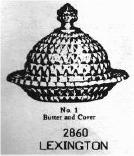 Introduced prior to 1917, the #2860 Design - a "Medium Pressed"
pattern (shown at left), was discontinued during the 1920s only to be reactivated
during the 1930s, probably between 1934 and 1937. Indications are the
butter dish was not one of the items made during the second production
period. However, there was a 7" cheese dish and cover, which resembles
the butter of prior years. No mention of the cheese is found on a price
list from the early 1920s.
Introduced prior to 1917, the #2860 Design - a "Medium Pressed"
pattern (shown at left), was discontinued during the 1920s only to be reactivated
during the 1930s, probably between 1934 and 1937. Indications are the
butter dish was not one of the items made during the second production
period. However, there was a 7" cheese dish and cover, which resembles
the butter of prior years. No mention of the cheese is found on a price
list from the early 1920s.
During the second production period for this line, it was known as "Lexington" and period advertising featured illustrations of the Lexington MinuteMen. Made only in crystal during the early years, and apparently without a factory assigned name, the twenty pieces known to have been made during the 1930s were pressed in both amber and crystal. Based on several items in a private collection, it appears the line was not signed during either production period.
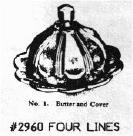 Known to Cambridge collectors as "Four Lines" pattern, the #2960
Medium Pressed Design (at right) was brought out during the years 1910-16. Phyllis
Smith, writing in the Crystal Ball some years ago, had this to say
about #2960:
Known to Cambridge collectors as "Four Lines" pattern, the #2960
Medium Pressed Design (at right) was brought out during the years 1910-16. Phyllis
Smith, writing in the Crystal Ball some years ago, had this to say
about #2960:
"So far, we have not found one piece in this pattern marked "Nearcut", but we have one bowl with the old large
in the bottom."
" ... some of the pieces that have been found are absolutely beautiful in the clear, lovely, quality crystal Cambridge was known for, while other pieces have been found in very poor quality crystal. Why??? Sure wish we knew."
The existence of a piece of this #2960 marked with the ![]() ,
indicates at least one mold from the line was still being used sometime
during the years 1923-26; the period in which use of this mark is
generally believed to have first occurred.
,
indicates at least one mold from the line was still being used sometime
during the years 1923-26; the period in which use of this mark is
generally believed to have first occurred.
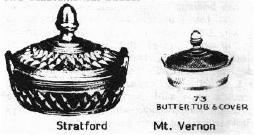 The Stratford pattern (at left) was first seen by the public sometime between
1915 and 1922, with the actual date probably being closer to the latter
date. It apparently was not included in the original issue of the
Cambridge Catalog #10, circa 1920-21, but was later added via two
supplemental pages.
The Stratford pattern (at left) was first seen by the public sometime between
1915 and 1922, with the actual date probably being closer to the latter
date. It apparently was not included in the original issue of the
Cambridge Catalog #10, circa 1920-21, but was later added via two
supplemental pages.
(Editors Note: Observe the change in the size of the pattern design of the early Stratford and the later Mt. Vernon.)
By 1922, the pattern was appearing in China, Glass and Lamps as Old English Stratford; perhaps the name change being done with the hope of increasing sales. Discontinued during the mid 1920s, the Stratford line reappeared under the name "Early American Glassware - Mount Vernon Pattern" in 1931. A 5" butter tub and cover was included in the original Stratford line and as such was made only in crystal. For a discussion of the Mount Vernon butter tub, see Part I of this series.
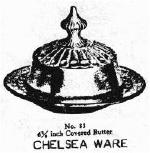 "Chelsea Ware" (at right) as it was designated in Cambridge catalogs, was
probably first sold to the trade in late 1920 or early 1921. An
advertisement in the December 6, 1920 issue of China, Glass and
Lamps illustrated two pieces of this line and in the text was this
statement: "See our complete display of this new line of Tableware and
Novelties." Chelsea was a large line consisting of over 150 pieces.
"Chelsea Ware" (at right) as it was designated in Cambridge catalogs, was
probably first sold to the trade in late 1920 or early 1921. An
advertisement in the December 6, 1920 issue of China, Glass and
Lamps illustrated two pieces of this line and in the text was this
statement: "See our complete display of this new line of Tableware and
Novelties." Chelsea was a large line consisting of over 150 pieces.
It is possible that Chelsea was the last of its type of pressed ware to be brought out during what has become known as the Nearcut years. How long the line remained in production is unknown, but since it is infrequently found today, It would appear not a great amount of Chelsea was made, thus indicating a short production period. Pieces are known in cobalt blue I, azurite and topaz, indicating some of the molds were still being used in 1923, the year topaz was introduced. To my knowledge the butter has not been found in color.
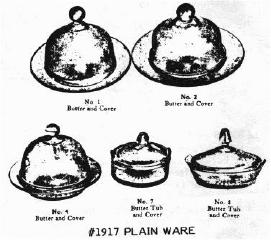 By the time the 1920s were well underway, the emphasis by Cambridge
on heavy pressed and imitation cut glass was fading. This is
illustrated by the showing, in Catalog #10, of what was called #1917
Plain Ware (pieces illustrated at left). This was, of course, pressed ware,
but in a new, plain,
lighter appearing style, and there was no attempt to imitate cut or
pattern glass. The first known catalog illustration of this line
included no less than five butters.
By the time the 1920s were well underway, the emphasis by Cambridge
on heavy pressed and imitation cut glass was fading. This is
illustrated by the showing, in Catalog #10, of what was called #1917
Plain Ware (pieces illustrated at left). This was, of course, pressed ware,
but in a new, plain,
lighter appearing style, and there was no attempt to imitate cut or
pattern glass. The first known catalog illustration of this line
included no less than five butters.
During the very early years of the Plain Ware line, it was made only in crystal. As Cambridge began to introduce its opaque and transparent colors, they were used in conjunction with the Plain Ware line. There is no definitive listing of all colored Plain Ware and thus a Plain Ware butter in mulberry, emerald, amber, cobalt blue I, helio, primrose, azurite or other colors cannot be ruled out.
Without their covers, the #7 and #8 Plain Ware butter tubs were called lemon tubs. Thus, if one finds a bottom to either, there is a choice as to what to call it, a butter bottom or lemon tub. Your choice of names will probably depend on what you want or need for your collection.
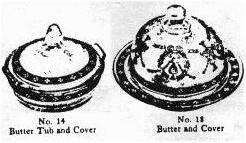 It was during the early 1920s when the first deep plate etched
butters appeared in a Cambridge catalog (#10). In this catalog
we find the #14 butter tub and cover and the #18 butter tub and cover,
etched Wedgewood (shown at right); and the #14 butter is also shown with the Dresden
etching.
It was during the early 1920s when the first deep plate etched
butters appeared in a Cambridge catalog (#10). In this catalog
we find the #14 butter tub and cover and the #18 butter tub and cover,
etched Wedgewood (shown at right); and the #14 butter is also shown with the Dresden
etching.
At the same time, the #1917/8 butter tub and cover was illustrated with two etchings, #4072 and #4077.
The Plain Ware line, as a complete line, had been discontinued by 1927, as had been the Dresden and Wedgewood etchings.
With the Plain Ware line, we come to the end of the Cambridge butter dish story. Part I, published in February 1987 started with the late 1920s and ran through the demise of the company. Part II, published in November 1987 covered the early years. As the 1940s dawned, many of the molds used to make the lines described in this article, as well as those in Part II, were destroyed.
With the exception of the Caprice butter dish, all Cambridge butters found today are original factory products. The collector can be sure of having an authentic Cambridge piece and not a reproduction or reissue.
The Caprice butter dish has been reissued using the original molds in a transparent blue color resembling moonlight. I have no knowledge of the Caprice butter dish in crystal being made at this time.
